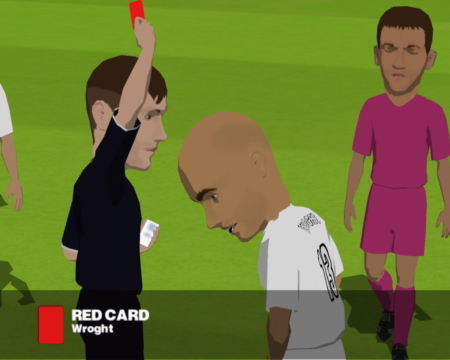
Sensible Soccer 2006
Written by: Rik
Date posted: December 29, 2020
- Genre: Sport
- Developed by: Kuju Entertainment
- Published by: Codemasters
- Year released: 2006
- Our score: 3
Back when when the initials of the digital store GOG stood for Good Old Games, and their library was rather more limited than it is now, the addition of Sensible Soccer 2006 was accompanied by howls of protest, partly on the basis that this game was far too recent a title to be added to what was then a retro-focused endeavour, and partly because the game itself was considered to be of poor quality. (One comment, along the lines of, ‘It’s not GOOD, it’s not OLD, and it’s not a GAME’, seemed to represent the general tenor of discourse at the time).
To be fair, at that point the original Sensible Soccer titles were not available to purchase, and they would have been a more logical addition to GOG than this remake/reimagining. However, the harsh comments regarding quality were in stark contrast to the fairly positive reception I recalled the game receiving at the time of release, with PC Zone awarding a moderate recommendation, and Eurogamer dishing out a score of 9/10 to the console version, although the latter wasn’t without controversy, with unsubstantiated accusations of corruption in the comments causing some angry back and forth to rage for some time.
To some extent, when dealing with modern remakes of ‘classic’ football games, it was ever thus. Similar issues surrounded the previous attempts to update Sensible Soccer, games which received contemporary reviews full of praise that nevertheless struggled to meaningfully position them against their flashy modern rivals. In time, these favourable write-ups were exposed as hasty at best, and were soon quickly, and quietly, disowned.
Sensible Soccer 98, reviewed some months earlier in PC Zone as Sensible Soccer 2000, ultimately saw a commercial release just in time for the 1998 World Cup, something it has in common with this effort, arguably rush-released suspiciously close to the 2006 tournament (and possibly also rush-reviewed in order to gloss over the many glaring faults within). Though this is superficially a more polished effort than the chunky boxiness of the previous iteration, with stylised cel-shaded graphics that have aged pretty well and retain a certain charm, within the first hour of play some fairly fundamental flaws become apparent.
Put simply, the game is far too easy. These days, the term ‘broken’ is used to describe a modern title with flawed puddle reflections [you’re getting dangerously close to sounding like an old man there – FFG reader], but I’d say it can fairly be applied here. The AI puts up very little resistance, and you can dominate possession even while you first get your head around reliable methods of scoring, of which there are many. Once you do, every match becomes a procession, with ludicrous scorelines the norm. To illustrate, your correspondent’s debut season with Leeds United, at this point a middling second-tier team in real life, brought over 130 points and 230 goals. That’s an average of five goals per game, and on reflection the two defeats suffered, even against a total of 44 in the win column, are embarrassing to report. (To be fair, one was in my first ever game).
Under such circumstances, it soon became obvious that, as a piece of entertainment, Sensible Soccer 2006 runs out of gas after a handful of matches. If a football game was like an RPG in which you were rewarded somehow for repetitively crushing puny enemies, it might hold some appeal, but beyond satisfying your curiosity regarding how great a margin of victory can be achieved (15-0 was my best), the lack of challenge soon becomes tiresome. The AI is simply feeble, and even if you give the ball away, it’s very easy to get it back, with precision or slide-tackling rarely required and a strange semi-automatic coming together of players generally resulting in you winning possession again. Opposition throw-ins often involve the ball being just thrown straight back to you.Shots don’t go in from any and all angles, but the control system and lack of pressure on the ball mean that it’s quite easy to launch a powerful one, and get it on target. And, as you rain attempts down on the opposition goal, some flaws with AI ‘keepers reveal themselves. Their style is very much of the low-effort ‘crouch slightly to one side’ variety, and soon you’ll find ways to punt it past their half-hearted dives with ease and regularity. Better teams have better goalies, but their improved abilities don’t manifest themselves in more realistic behaviour: instead, they just occasionally warp themselves towards the ball as needed to make unlikely and impossible saves. (Oh, and there’s no adjustable difficulty level, either, so the only way to increase the challenge is to play as a really crap team.)
It’s a shame, because there’s the core of something decent there, and while for purists the core of Sensible Soccer is for only one button to be required, and that the ball does not stick to the players’ feet, the concessions here to modern efforts may be welcome to others. Whether by accident or design, Sensible Soccer 2006 builds on the previous update by adding a third button – pace – to the existing pass and shoot options. In possession, it all works fairly well, and though it may be rather lacking when it comes to subtle and deft touches, it’s possible to build up some rhythm in an occasionally satisfying manner. Indeed, the goals that are scored following a passing move are generally more gratifying than the punts from outside the box that regularly find the net.
Other than the graphics, and the three-button system, there are very few other parallels with contemporary mid-00s efforts from the FIFA and Pro Evolution series. There’s no career mode as such, and you’re limited to individual tournaments. Tactics and management features are basic: squads boast only 16 players, names are misspelled, and there are no stats other than an overall rating. Players can be fatigued during a match but it doesn’t carry over during a tournament. Squads are missing replacements in key positions anyway, and the system of using initials as a shorthand both for players and a summary of their preferred position leads to a confusing mess of letters on the tactics screen. In-game, sound effects are sparse and there’s no commentary, while adverts for fictional products and services are mixed in with multiple hoardings bearing the name of Britain’s cheapest daily tabloid, the Daily Star.
In recent years, Sensible Soccer seems to have been remembered as a bit of a laugh, with even Sensible supremo Jon Hare happy to join in with wider nostalgic reminiscences about a better past, in which games were more fun and didn’t take themselves too seriously. A more sober analysis might be that it was a time when anyone could make a football game that could be successful, whereas now it is almost impossible to see how an independent game could compete with the budgets and resources of the big boys.
But it also does the original game a disservice to dismiss it as a bit of a lark, just because it had a few comedy custom teams and some catchy intro music. Back in the 90s, Sensible Soccer was one of the big boys. Most of all, it demonstrated an understanding that people wanted a game that was serious about football: the teams, the kits, the player names. And that principle continued into Sensible World of Soccer, with its ambitious multiple leagues and pseudo-management season mode. Daft graphics and silly misspelled names weren’t part of the brand back then.
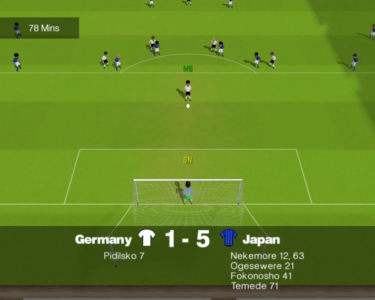
As in all cases in which the AI is awarded a penalty, and inexplicable as it may seem, Germany are about to miss this one.
Indeed, apart from the top-down view, the oversized player heads, and a remix of the SWOS intro song ‘Goalscoring Superstar Hero’, it doesn’t really have much in common with 90s Sensible Soccer at all. The mixture of occasionally slick play and baffling flaws give the impression of a game that was once something else, a proper modern footy title maybe, repurposed and rebranded. One theory that emerged and disappeared during the Eurogamer review controversy was that this was indeed the case, with Codemasters’ previous unsuccessful shot at the big time, Club Football, being the basis for this supposedly new Sensi title. (This was all covered here, if you’ll forgive the use of this source, which we’ve linked to before). I can’t personally claim to have done any further research into the matter, as despite my predilection for dreadful old footy titles, Club Football remains on the long list of dross that I haven’t got around to yet (and may never do so) but the link certainly makes a lot of sense.
Whatever the reasons, those grumpy old GOG-ers were correct in their appraisals: this is certainly not a good game. Perhaps it has some appeal as a multiplayer title, and inevitably one can unearth talk of a (now unavailable) fan megapatch that once existed and fixed many problems (although based on your correspondent’s experiences with such things in the murky world of 00s cricket games, this seems doubtful). As it stands, as a single-player game, you’ll master it in 30 minutes or so, leaving very little point in exploring the tournaments on offer, other than to see what the trophy presentation looks like. (To save you the trouble: it’s quite good, but an unintended side-effect of the large player heads is that their comparatively short arms cannot extend sufficiently to lift the cup above them. Which sort of sums the game up, really).

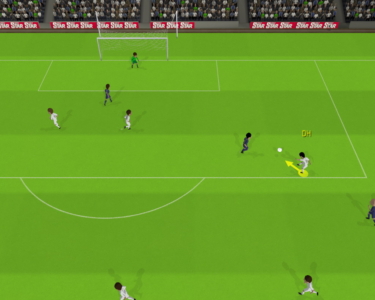
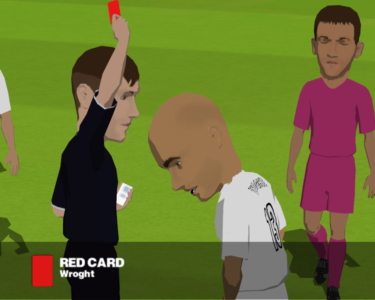
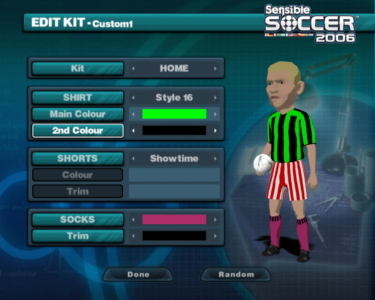

 Posts
Posts